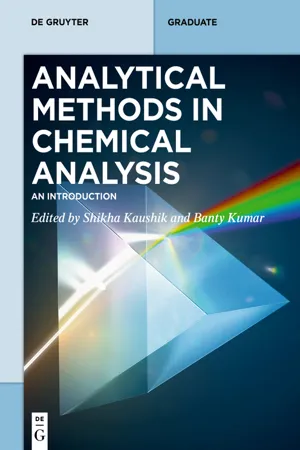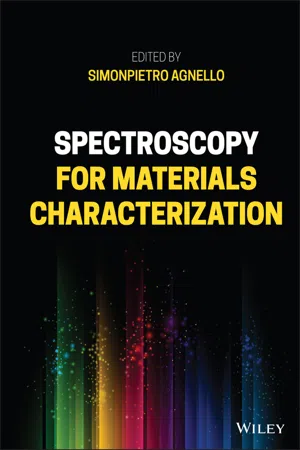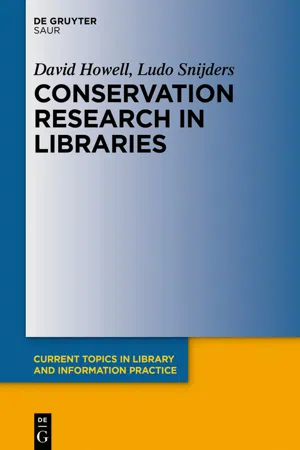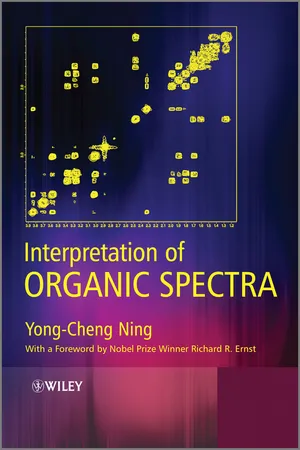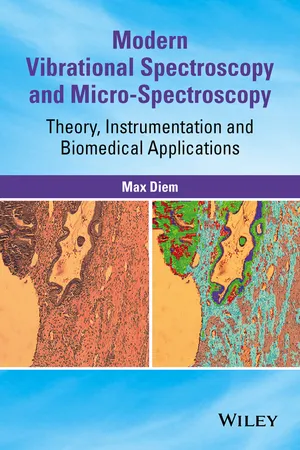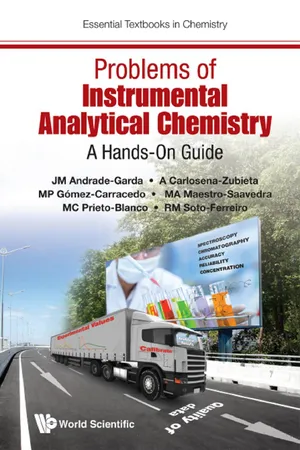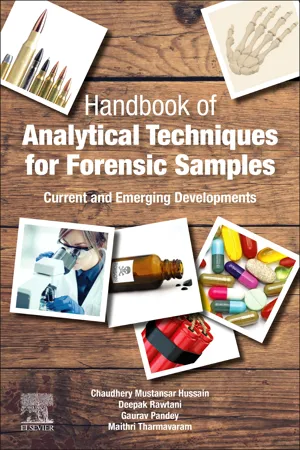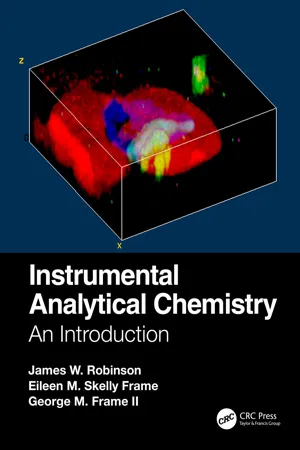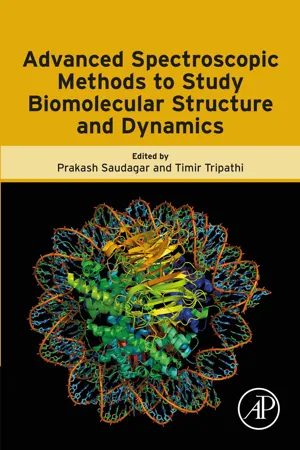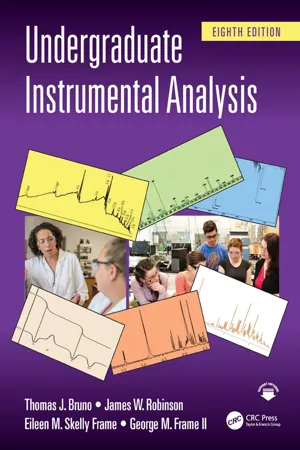Chemistry
Infrared Spectroscopy
Infrared spectroscopy is a technique used to analyze the chemical composition of a substance by measuring the absorption of infrared radiation. It provides information about the functional groups present in a molecule, allowing for identification and characterization of organic compounds. By measuring the energy absorbed by different chemical bonds, infrared spectroscopy can be used to determine molecular structure and composition.
Written by Perlego with AI-assistance
Related key terms
12 Key excerpts on "Infrared Spectroscopy"
- eBook - ePub
Analytical Methods in Chemical Analysis
An Introduction
- Shikha Kaushik, Banty Kumar, Shikha Kaushik, Banty Kumar, Shikha Kaushik, Banty Kumar(Authors)
- 2023(Publication Date)
- De Gruyter(Publisher)
In this chapter, we have discussed the different regions of infrared (IR) spectroscopy, basic principle governing IR spectroscopy, different modes of vibrations, and factors affecting IR frequency. The IR spectra have been displayed in the chapter at relevant place which makes it easier for the students to understand the topic, and they will learn the identification of different functional groups in a molecule.5.1 Introduction
Spectroscopy is a versatile and significant method of understanding and elucidating the structure of molecules by measuring the interaction of light and matter. There are numerous benefits of spectroscopy, and it is employed in virtually every area of scientific research ranging from environmental analysis to biomedical sciences. Infrared (IR) spectroscopy is one of the most simple, reliable, and important analytical tools that is widely used in research and industry and provides qualitative information in a fast and cost-effective manner.Any spectrum of molecule recorded by different analytical technique has its own unique pattern which corresponds to only that particular molecule. IR spectroscopy plays an important role in deducing the structure of an unknown compound, and it usually deals with the identification of functional groups present in a molecule. All the functional group gives characteristics bands in IR spectra, and the spectrum recorded is the reflection of molecular structure under study which includes unique properties such as band position, band width, and band intensity.IR spectroscopy deals with the IR region of electromagnetic spectrum. It is based on the study of absorption of IR radiations, and these radiations induce transition between vibrational energy levels (v1 , v2 , v3 , …) in the molecule. When the supplied energy is equal to difference between vibrational energy levels, absorption of IR radiation takes place, and a peak is observed. Almost any organic compound, having covalent bonds absorb electromagnetic radiations in the IR region of the electromagnetic spectrum, and it includes radiations that lies in the wavelength range from 0.8 to 1,000 μm (1 μm=10–6 - eBook - ePub
- Simonpietro Agnello, Simonpietro Agnello(Authors)
- 2021(Publication Date)
- Wiley(Publisher)
5 Infrared Absorption Spectroscopy Tiziana Fiore and Claudia Pellerito Department of Physics and Chemistry – Emilio Segrè, University of Palermo, Palermo, Italy 5.1 Fundamentals Infrared (IR) absorption spectroscopy is one of the most important analytical techniques available to study different kinds of samples including solids, semisolids, powders, polymers, biological materials, films, liquids, solutions, and gases. One of the great advantages is that IR spectroscopy is a nondestructive technique commonly applied to characterize the chemical structure and identify the chemical bonds in unknown materials. Qualitative identification of organic and inorganic compounds is a primary purpose of IR spectroscopy, even if IR absorption can also be used to provide quantitative measurements of compounds. The infrared range of the electromagnetic spectrum covers the wavelength region from 0.7 μm to 1 mm, which conforms to the wavenumber range 14,285–10 cm −1. The entire IR region can be divided into the near IR region (0.7–2.5 μm, 14,285–4000 cm −1), the mid‐IR region (2.5–50 μm, 4000–200 cm −1), and the far‐IR region (50–1000 μm, 200–10 cm −1). Chemists most often work in the mid‐IR region where many molecules have strong absorbances and specific vibrational frequencies corresponding to discrete vibrational energy levels, which characterize the infrared spectrum of each compound. IR spectroscopy became widely used after the development of dispersive infrared spectrometers in the 1940s [1]. The basic components of a dispersive IR spectrometer included a radiation source, monochromator, and detector. This type of instrument helped to spread the use of IR spectroscopy as a common analytical technique for organic compounds characterization in basic and industrial research - eBook - ePub
- David Howell, Ludo Snijders(Authors)
- 2020(Publication Date)
- De Gruyter Saur(Publisher)
Fourier transform infrared (FTIR) spectrometers were developed for commercial use in the 1960s, but they were expensive and required complex optical components and large computers to run them. Technological advances in both computation and instrumentation have simultaneously reduced the cost and increased the power of an FTIR, so that IR spectroscopy is now more available, easier to use, faster and more accurate. FTIR instruments are now being used for chemical compound identification in many analytical laboratories, including laboratories in museums, libraries and other heritage institutions. Like the dispersive instrument described above, an FTIR instrument also has an IR radiation source and IR (thermal) detector and is capable of producing high-quality IR spectra. The principle of operation is however very different with the theory of FTIR being much more mathematical and hence less intuitive. The improvement of spectral resolution and the lowering of detection limits obtained with FTIR instruments has allowed much more use of this technique for study of cultural heritage materials. In FTIR spectrometers, instead of the spectra being collected by sequentially scanning through each of the wavenumbers, all of the wavenumbers are scanned simultaneously, producing an interferogram. This can then be converted by a mathematical procedure called a Fourier transform into a conventional display of a spectrum such as described for the dispersive instruments. The resulting spectrum is thus the same, but the FTIR is much quicker and efficient.The underlying physics of all types of IR spectroscopy is the same. IR spectroscopy detects the vibrational motion of the atoms within a molecule which in turn depends upon the atoms present in a substance and the nature of the bonds connecting them. The IR spectrum can be used to either provide a characteristic fingerprint of a substance or to provide clues as to the chemical groups, or functional groups, within a molecule. The measurement itself revolves around the absorption of infrared radiation by the substance. The reason that IR spectroscopy is such a useful diagnostic method lies in the way in which IR radiation interacts with molecules. From a chemical perspective all molecules are made up of chemical bonds made between individual atoms, molecules are constantly vibrating with movements of the bonds between its constituent atoms. These vibrations distort the shape (structure) of the molecule in various ways. This includes the bonds between the atoms stretching, bending, scissoring, rocking, wagging and twisting (for a complete introduction see Callister and Rethwisch 2007 - eBook - ePub
- Yong-Cheng Ning(Author)
- 2011(Publication Date)
- Wiley(Publisher)
Chapter 5 Interpretation of Infrared SpectraAlthough NMR spectra are applied as a main tool for the identification of an unknown structure or the confirmation of an anticipated structure, the function of IR spectra still should not be neglected because of the following facts.5.1 Elementary Knowledge of Infrared Spectroscopy 5.1.1 Infrared Spectrum1. The IR spectrum emphasizes the information on some functional groups, especially strong polar functional groups. This is important to determining the existence of such functional groups.2. The measurement of IR spectra is the easiest one of all another spectroscopic methods. Any sample in a solid, liquid or gaseous phase can be measured by Infrared Spectroscopy.3. Commercial products, which are mixtures in general, are mostly suitable for being measured by IR spectroscopy. IR spectra can be used for the comparison between an unknown sample with a standard sample, and between a mixture with a commercial product.4. An organic compound can be differentiated easily from an inorganic compound by the IR spectrum, which is impossible or inconvenient if we use other spectroscopic methods.The abscissa of the infrared spectrum is the wavenumber, cm−1 . The commercial IR spectrometers usually cover 400–4000 cm−1 (medium IR region). The ordinate of the infrared spectrum is the intensity of the IR absorption, which uses transmittance in general.The peaks in the IR spectrum usually are not sharp peaks, some of which even have a rather broad width. Therefore, IR absorption signals can be named absorption peaks or absorption bands. - eBook - ePub
Modern Vibrational Spectroscopy and Micro-Spectroscopy
Theory, Instrumentation and Biomedical Applications
- Max Diem(Author)
- 2015(Publication Date)
- Wiley(Publisher)
Chapter 3 Infrared SpectroscopyIn this and the following chapter, the two main modalities for observing molecular vibrational spectra are discussed, starting with infrared (IR) spectroscopy. This field started in the late 1930s, using mostly home-built instruments that incorporated prism monochromators and thermocouple detectors and the most basic electronic amplification circuitry, because solid-state (or even digital) electronics was still decades in the future. Nevertheless, the value of IR spectroscopy as a qualitative structural tool was soon realized, and the methodology soon migrated from physics laboratories, where it was originally developed, into chemical laboratories, both in academe and industry, and soon became one of the first physical methods to aid in structure determination. Except for very high resolution studies and astrophysical applications, IR spectroscopy is now being used and developed largely in physical chemistry research, since this technique offers a phenomenally sensitive probe for molecular structure, conformation, interactions, and dynamics.The basic concepts of the theory of IR spectroscopy were introduced in Sections 1.2 –1.5 , and fundamental aspects of the observation of the effect were discussed in Section 1.6 . The selection rules based on molecular symmetry were introduced in Chapter 2 , and a few IR absorption spectra of small molecules were shown in Section 2.6 . In the following sections, basic optical concepts of the interaction of IR radiation with molecular samples are introduced, followed by a discussion of instrumentation for the observation of IR spectra. Finally, data collection strategies (i.e., transmission, reflection, attenuated total reflection (ATR), etc.) are discussed.3.1 General aspects of IR spectroscopy
IR spectra can be observed using several sampling methods and geometries that will be discussed in turn. However, in the most basic form of this technique, an IR photon is absorbed by the sample, causing excitation of one normal mode of vibration into a higher vibrational energy level. As pointed out earlier, such a process can be described by Eq. 1.114 , which states that the quantum mechanical transition moment determines the molar extinction coefficient - eBook - ePub
Problems of Instrumental Analytical Chemistry
A Hands-On Guide
- JM Andrade-Garda, A Carlosena-Zubieta;MP Gómez-Carracedo;MA Maestro-Saavedra;MC Prieto-BlancoRM Soto-Ferreiro(Authors)
- 2017(Publication Date)
- WSPC (EUROPE)(Publisher)
CHAPTER 4
INFRARED SPECTROMETRY
José Manuel Andrade-Garda andMaría Paz Gómez-Carracedo
OBJECTIVES AND SCOPE
The objective of this chapter is to present students the very basics of the chemical interpretation of an infrared (IR) spectrum. Explanations will be restricted to typical functional groups and relatively simple structures. Also, only the medium IR region and organic molecules will be considered. Quantitation issues are commented briefly since the multivariate statistical treatment is out of the scope of this book and classical calibration will be treated deeply in the other chapters. Therefore, the chapter focuses on the basics of IR spectra interpretation, something that somehow is not considered in many textbooks in analytical chemistry.1.INTRODUCTION
1.1.Basic concepts
Infrared (IR) spectrometry (or spectrometry in the infrared region, IR) is a molecular analysis technique of paramount importance in chemistry. Not in vain it is a powerful, ubiquitous workhorse to study and ascertain the main characteristics of molecular structures. Further, and in addition to this classical application, its use has fostered in the last two decades, thanks to its combination with multivariate chemometric techniques (mainly full-spectrum regression techniques like partial least squares, PLS). This conferred on IR spectrometry an unprecedent power to quantitate one or several species of interest in the analyzed aliquots. In conjunction with nuclear magnetic resonance (NMR) and mass spectrometry (MS), it constitutes a basic tool for most studies on organic and inorganic materials performed nowadays.Frequently, references to the ‘infrared region’ assume implicitly that work is performed at the medium IR range (MIR or mid-IR, 4000–600 cm−1 ), which is considered to offer a spectral ‘fingerprint’ of a substance [1 , 2 ]. However, nowadays the near infrared range (NIR, 13300–4000 cm−1 ) has become a very powerful and popular tool. The NIR range is used to study, mainly, harmonic vibrations of the functional groups. Practical applications using the far infrared region (FIR, 400–20 cm−1 ) are still pretty scarce, although they are increasing, thanks to the so-called terahertz spectroscopy [3 ], a term which somehow supersedes the FIR one. A relevant advantage of this region is that plastics, cloth and semiconducting materials are transparent, opening up ways to in situ - eBook - ePub
Handbook of Analytical Techniques for Forensic Samples
Current and Emerging Developments
- Deepak Rawtani, Gaurav Pandey, Maithri Tharmavaram, Chaudhery Mustansar Hussain(Authors)
- 2020(Publication Date)
- Elsevier(Publisher)
Infrared Spectroscopy is a type of vibrational spectroscopy in which the energy of the incident electromagnetic radiation is absorbed by the molecule, gets excited, and then undergoes rotations or vibrations. Infrared Spectroscopy is a widely used technique because of its versatility and rapid results. A myriad of liquids, solids, and gaseous samples can be easily analyzed using this technique. It also requires minimal sample preparation and based on the type of technique used, it can also be nondestructive in nature.This technique involves the use of infrared rays, and the amount of rays absorbed by the sample is taken into account. The principle and theory behind this technique will be discussed further in this chapter. While IR spectroscopy takes into account the vibrational energy of the molecules, another technique known as near-infrared takes into account both the electronic and vibrational transitions. This makes NIR a very unique technique capable of analyzing a wide range of molecules. The IR region lies between 700 nm and 1 mm while NIR lies between 800 nm and 1.2 mm.Quite often, samples are analyzed through an amalgamation of Raman, near-infrared, and IR spectroscopy in order to get a comprehensive idea about the compound. Forensic science extensively uses these techniques to analyze samples such as paints, explosives, drugs, and counterfeit compounds (Pandey et al., 2017 ; Rawtani et al., 2019 ). Because these techniques are nondestructive and reliable, they are capable of analyzing the samples. In this chapter, the use of IR and NIR in the analysis of biological samples, inks, questionable documents, explosives, gunshot residue, illicit and counterfeit drugs, bank notes, and paint is discussed. Also, the principle, theory, and instrumentation of the techniques are given.2: Principle and theory of infrared and near-Infrared Spectroscopy
2.1: Principle of Infrared Spectroscopy
Infrared Spectroscopy, just like any other spectroscopy technique, is based on the use of electromagnetic radiation to analyze compounds. Electromagnetic radiation consists of an electric and magnetic component that are perpendicularly aligned with each other and travel in a sinusoidal manner. As mentioned before, IR spectroscopy is based on the absorption of the IR by the sample, due to which it gets excited and starts to vibrate. The vibrational signal sent out is characteristic of each molecule and thus serves as the basis of this spectroscopy. - eBook - ePub
Instrumental Analytical Chemistry
An Introduction
- James W. Robinson, Eileen M. Skelly Frame, George M. Frame II(Authors)
- 2021(Publication Date)
- CRC Press(Publisher)
Qualitative analysis of unknown samples is a major part of the work of an analytical chemist. Since it is better to give no answer than an incorrect answer, most analytical chemists perform qualitative analysis using an array of techniques that overlap and confirm each other, providing in the sum more information than could be obtained with the separate individual methods. For qualitative analysis of an unknown organic compound, the most commonly used spectroscopic methods are: IR spectroscopy to see which functional groups are present; NMR to indicate the relative positions of atoms in the molecule and the number of these atoms; and MS to provide the molecular weight of the unknown and additional structural information. UV spectroscopy was used in the past to study unsaturated or substituted compounds; it has been almost entirely replaced for qualitative structural information by NMR and MS, which are commonly available in undergraduate chemistry labs. Each technique provides an abundance of valuable information on molecular structure, but a combination of methods is used to ensure more reliable identification. In addition to spectroscopy, real samples may be submitted to chromatography to determine if the unknown is a pure substance or a mixture, to determine the number of compounds present, and to separate and purify the compound of interest.The value to qualitative analysis of prior knowledge about the sample cannot be overemphasized. Before trying to interpret an IR spectrum, it is important to find out as much as possible about the sample. For example, to identify the products of an organic reaction, it is very valuable to have information about the materials that were present before the reaction started, the compounds the reaction was expected to produce, the possible degradation products that may come about after the reaction, and so on. Armed with as much of this information as possible, we may be able to identify the molecules in the sample from their IR spectra.The general technique for qualitative analysis is based on the characteristics of molecular structure and behavior mentioned at the beginning of the chapter. That is, the frequency of vibration of different parts of a molecule depends on the weight of the vibrating atoms (or groups) and the bond strength. Many groups can be treated as isolated harmonic oscillators and their vibrational frequencies calculated. More commonly, vibrational frequencies for functional groups are identified by the collection of spectra from hundreds of different compounds containing the desired functional group. These characteristic group vibrational frequencies are tabulated in correlation tables or correlation charts. Table 4.2 - eBook - ePub
Forensic Examination of Glass and Paint
Analysis and Interpretation
- Brian Caddy, Brian Caddy(Authors)
- 2001(Publication Date)
- CRC Press(Publisher)
Atlas. This section covers only very basic theory.Infrared Spectroscopy can usefully be described as an instrumental method of analysis in which light falling in the wavelength range of IR radiation is passed through or reflected off a sample. Light of various wavelengths may be absorbed depending on the chemical composition of the sample. The instrument output is an IR spectrum in which the intensity of IR radiation absorbed or transmitted is plotted on the y-axis against the frequency or wavelength of the radiation on the x-axis. The spectrum may be interpreted to determine functional groups of elements or compared to spectra from other samples or standards collections to establish identity, similarity or differences.Wavelength is measured in subunits of the metre – most commonly the nanometre (nm) (1nm = 1×10-9 m) and the micrometre or micron (μm) (1μm = 1×10-6 m). Spectra recorded in the 1960s and early 1970s often used wavelength measured on the micrometre scale on the x-axis, but in current practice, wavelength has been superseded by a frequency unit, the wavenumber (cm-1 ). The wavenumber is the number of waves in a length of 1cm and is the reciprocal of wavelength in cm. The spectra in this chapter have percentage transmission on the y-axis and wavenumber on the x-axis.The infrared region of the electromagnetic spectrum extends from c. 12,500 to 50cm-1 . Only the range of 4000–200cm-1 is of interest to the forensic chemist because the energy of that IR radiation lies in the same range as the energy of vibrational transitions or fundamental modes of vibration within molecules. Molecular vibration changes the interatomic distances between atoms to produce an alternating dipolar electric field. When electromagnetic energy passes through the sample, and the energy frequency (v - Prakash Saudagar, Timir Tripathi, Prakash Saudagar, Timir Tripathi(Authors)
- 2022(Publication Date)
- Academic Press(Publisher)
Chapter 6: Applications of Infrared Spectroscopy to study proteins
Riya Sahua ; Banesh Soorama ; Santanu Sasidharana ; Niharika Nagb ; Timir Tripathib , c ; Prakash Saudagaraa Department of Biotechnology, National Institute of Technology Warangal, Warangal, Indiab Molecular and Structural Biophysics Laboratory, Department of Biochemistry, North-Eastern Hill University, Shillong, Indiac Regional Director's Office, Indira Gandhi National Open University (IGNOU), Regional Center Kohima, Kohima, IndiaAbstract
Owing to its sensitivity to chemical makeup and structure, one of the most used approaches to analyze the structure of small molecules is infrared (IR) spectroscopy. In addition to its sensitivity, IR spectroscopy provides extensive data to study protein structure, biological systems, molecular and chemical processes, and mechanisms of protein misfolding, folding, and unfolding. The use of information received from the IR spectrum is not only limited to the analysis of proteins but also used to explore other biological systems such as the classification of microbes and the identification of bacterial strains. IR spectroscopy has a wide range of applications ranging from small soluble proteins to large membrane proteins. The method requires less effort, is economical, and gives high time resolution within a short span of measurement time and with a low amount of sample requirement. This article discusses the applicability of the middle region of the IR spectra for studying protein reactions utilizing reaction-driven IR difference spectroscopy.Keywords
Infrared Spectroscopy; FTIR; Protein structure; Protein function; Secondary structures1: Introduction
Owing to its sensitivity to chemical makeup and structure, one of the most used approaches to analyze the structure of small molecules is infrared (IR) spectroscopy. In addition to its sensitivity, IR spectroscopy provides extensive data to study protein structure [1 –11 ], biological systems, molecular and chemical processes [1 ,2 ,9 ,12 –31 ], and mechanisms of protein misfolding, folding, and unfolding [8 ,9 ,11 ,23 ,28 ,32 –38- eBook - ePub
- David G. Watson(Author)
- 2020(Publication Date)
- Elsevier(Publisher)
5: Infrared spectrophotometry
- Introduction,
-
Factors determining intensity and energy level of absorption in IR spectra,
- Intensity of absorption,
- Energy level of absorption,
-
Instrumentation,
- Instrument calibration,
- Sample preparation,
- Application of IR spectrophotometry in structure elucidation,
- Examples of IR spectra of drug molecules,
-
IR spectrophotometry as a fingerprint technique,
- Preparation of samples for fingerprint determination,
- IR spectrophotometry as a method for identifying polymorphs,
- Near-infrared analysis (NIRA),
- Introduction,
-
Examples of NIRA applications,
- Determination of particle size in United States Pharmacopoeia (USP) grade aspirin,
- Determination of blend uniformity,
- Determination of active ingredients in multicomponent dosage forms,
- In-pack determination of active ingredients,
- Determination of polymorphs,
- Moisture determination,
- Process control of components in a shampoo,
KeypointsPrinciples-
• Electromagnetic radiation ranging between 400 cm− 1and 4000 cm−
- eBook - ePub
- Thomas J. Bruno, James W. Robinson, George M. Frame II, Eileen M. Skelly Frame(Authors)
- 2023(Publication Date)
- CRC Press(Publisher)
Standard Methods for the Examination of Water and Wastewater, 18th edn. American Public Health Association: Washington, DC, 1992.- Gremlich, H.-U.; Yan, B. (eds.)
Infrared and Raman Spectroscopy of Biological Materials. Marcel Dekker, Inc.: New York, 2001.- Griffiths, P.R.; de Haseth, J.A.
Fourier Transform Infrared Spectrometry. Chemical Analysis, Vol. 83. Wiley-Interscience: New York, 1986.- Heil, C. Rapid, multi-component analysis of soybeans by FT-NIR spectroscopy. Thermo Fisher Scientific application note, www.thermo.com , ©2010 Thermo Fisher Scientific, Madison, WI (www.thermofisher.com ).
- Herrero, A.M.; Carmona, P.; Careche, M. Raman spectroscopic study of structural changes in Hake (Merluccius merluccius L.) muscle proteins during frozen storage.
J. Agric. Food Chem., 52(8), 2147, 2004.- Hsu, C.-P.S. Infrared Spectroscopy. In Settle, F.A. (ed.),
Handbook of Instrumental Techniques for Analytical Chemistry. Prentice Hall PTR: Upper Saddle River, NJ, 1997.- Humecki, H.J. (ed.)
Practical Guide to Infrared Microspectroscopy. Practical Spectroscopy Series, Vol. 19. Marcel Dekker, Inc.: New York, 1995.- Ingle, J.D., Jr.; Crouch, S.R.
Spectrochemical Analysis. Prentice Hall, Inc.: Englewood Cliffs, NJ, 1988.- Kawai, N.; Janni, J.A. Chemical identification with a portable Raman analyzer and forensic spectral database.
Spectroscopy, 15(10), 32, 2000.- Kneipp, K.; Moskvits, M.; Kneipp, H. (eds.)
Surface-Enhanced Raman Scattering: Physics and Applications. Topics in Applied Physics, Vol. 103. Springer: New York, 2006.- Lambert, J.B.; Shurvell, H.F.; Lightner, D.; Cooks, R.G.
Introduction to Organic Spectroscopy. Macmillan Publishing Company: New York, 1987.- Lowry, S.
Using FT-IR Spectroscopy to Analyze Gemstones: Application Note 51123. Thermo Fisher Scientific: Madison, WI, 2006.- Marbach, R.; Kosehinsky, T.; Gries, F.A.; Heise, H.M. Noninvasive blood glucose assay by NIR diffuse reflectance spectroscopy of the human inner lip.
Appl. Spectrosc., 47(7), 875, 1983.- McLain, B.L.; Hedderich, H.G.; Gift, A.D.; Zhang, D.; Jallad, K.; Haber, K.S.; Ma, J.; Ben-Amotz, D. Fast chemical imaging.
Spectroscopy
Index pages curate the most relevant extracts from our library of academic textbooks. They’ve been created using an in-house natural language model (NLM), each adding context and meaning to key research topics.
